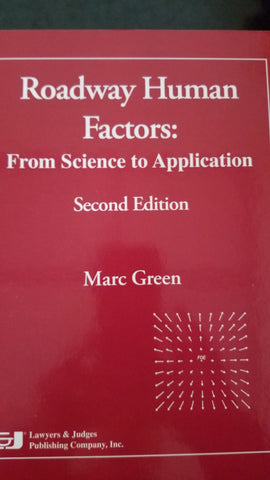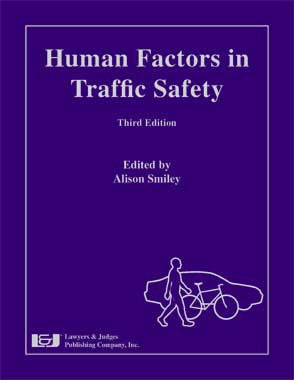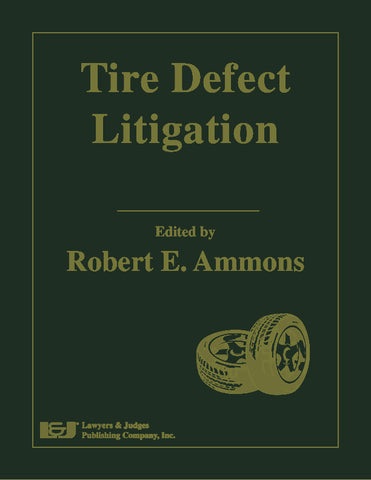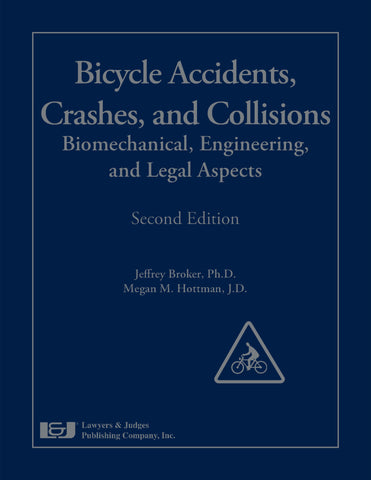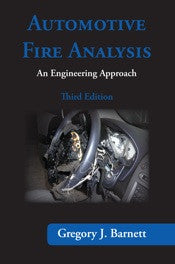
Automotive Fire Analysis 3rd Edition with DVD
- Author: Gregory J. Barnett
- ISBN 10: 1-936360-15-2
- ISBN 13: 978-1-936360-15-4
- Copyright Date Ed: April 12, 2013
- Pages: 182
- Binding Information: Paperback
- Size: 6 ✕ 9 Inches (US)
Data involving post-crash vehicle fires has historically been involved in litigation and therefore is difficult to obtain. Outside research funding goes toward personal injury prevention studies rather than property damage prevention studies, the category into which auto fires generally fall. It is difficult and expensive for manufacturers to test for the possibility of auto fires before models are released, and if studies are done, the data is usually not readily available for fear of litigation. As fires are chaotic events they are difficult to statically model, as each fire is likely to be unique. Fire departments are not called in on the majority of auto fires and fire department and arson investigation personnel are not generally trained in the specifics of motor vehicles, so little information is available there. As auto manufacturers increasingly work toward fuel efficiency, the nature, incidence and severity of collision and non-crash auto fires is likely to worsen.
In the new Automotive Fire Analysis: An Engineering Approach, Third Edition, experienced field engineer Gregory Barnett points out common problems with the way automotive fires are investigated. Mr. Barnett has compiled the research undertaken to date by manufacturers, standards organizations and private institutions into one compact guide. Mr. Barnett guides you through the proper techniques of vehicle fire analysis and investigation, typical vehicle fires and burn patterns, and indicators of arson in auto fires. He teaches you how to tell the difference between flame-resistant and flammable materials, the flammable liquids contained in cars, auto electrical systems and related fires, and more. This expanded third edition contains brand new sections on alternative fuel vehicles and the types of fires associated with them, including lithium-ion batteries, supplemental restraint systems, and golf cart fires. He covers the current safety standards for autos in the United States, in a clear and easy to follow manner. He gives you important information on functioning as a witness in court on auto fire cases.
This edition also contains a DVD with additional information and hours of video footage on auto fires and auto fire investigation.
Table of Contents
Chapter 1: Introduction
1.1 Background of the Problem
1.2 Reasons for Lack of Information on Vehicle Fire
1.3 Statement of the Problem
1.4 Purpose of the Book
1.5 Definitions of Terms
1.6 Limitations of the Book
Chapter 2: A History of Codes and Standards
2.1 Introduction
2.2 Federal Motor Vehicle Safety Standard Number 302
2.3 Society of Automotive Engineers Standard J369
2.4 Society of Automotive Engineers Standard J1344
2.5 International Standards Organization Number 14004
2.6 International Standards Organization Number 1043-1
2.7 International Standards Organization Number 1043-2
2.8 International Standards Organization Number 1043-4
2.9 International Standards Organization Number 1629
2.10 International Standards Organization Number 11469
2.11 Deutsch Institut für Normung Number 260
2.12 American Society of Testing and Materials Standard 1600
2.13 International Standards Institute Standards Numbers 472 and 1087
2.14 Conclusion
Chapter 3: Automotive Fire Mechanisms
3.1 Fire Behavior Basics
3.2 Exhaust System Fires
A. Foreign objects on the exhaust
B. Truck bed floorboard fires from the exhaust
C. Underhood fluids
D. On-board flammable and combustible liquids
1. Gasoline
2. Power steering fluid, transmission fluid, and hydraulic ride fluid
3. Brake fluid
4. Coolant
5. Engine oil
6. Fuel injection
7. Air filters
8. Windshield washing fluid
9. PAG and refrigerant oils
E. Conclusion
3.3 Electrical Systems and Fire
A. Battery fire
B. Alternator fires
C. Starter motor fires
D. HVAC and other electric motor fire
E. Engine ignition coil
F. Electrical switch fire
G. Solenoids
H. Wiring looms
I. Power Distribution Module
J. Headlamps
K. Electric seat track or seat heaters
L. High current flow computer modules
3.4 Add-On and Optional Equipment
3.5 Gas Tank Systems
3.6 Evaporative Emissions Systems
3.7 Electrical Fire Evidence
3.8 Normal Burn Temperatures and Burn Patterns
3.9 Arson Indicators
3.10 Signs of Arson
A. Whitish coating
B. Low burn patterns
C. Melted pools of glass
D. Extreme consumption of polymerics
E. Fire burning under engine or floor pan
F. Fire in different compartments
G. Destruction of steering column
H. Destruction of large aluminum castings
3.11 Alternative Technology Vehicles
A. Bi-Fuel Vehicle
B. Flex-Fuel Vehicle
C. Compressed Natural Gas
D. Liquid Natural Gas
E. Gas-Electric hybrid vehicles
F. Fuel Cell Vehicles
G. Lithium-ion batteries
1. Failure modes
H. Supplemental restraint systems and Event Data Recorders
I. Golf cart fires
1. Gas-powered golf carts
1. Electric golf carts
Chapter 4: Automotive Composites
4.1 Early Plastics
4.2 Thermoplastics and Thermosetting Plastics
4.3 Olefins and Polyolefins
4.4 Rubber and Rubber Components
4.5 Polymerics and Nanocomposites
Chapter 5: The Engineer in the Courtroom
5.1 Proper Investigation Techniques
5.2 Proper Scene Photography
5.3 Forensic Tools
5.4 Subrogation Issues
5.5 Arbitration
5.6 The Superior Court Action
References

